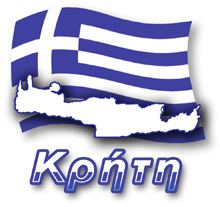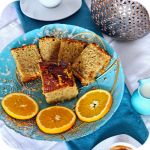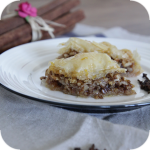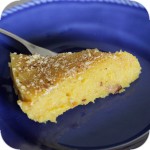

Melomakarona is a fragile cookie enchanting with a delicate orange-spicy note. Together with kourabiedes and kolourakia, they are present on Greek tables during Christmas. After baking, they are dipped in sweet honey-cinnamon syrup and sprinkled with nuts. If you are missing Greek flavors on holidays, add a delicious melomakarona to traditional Polish sweets.
Melomakarona, the most popular name for these cakes, consists of a mixture of two words: meli (μέλι) denoting honey, and Greek-Latin pasta, which can be translated as kneading or a much better-matched maceration. As you can see, this name contains the quintessence of taste and the way of preparing these Greek sweets.
It is quite possible that the second part of the name may also be the result of Venetian and Italian influences. Macarone are small cookies that are so popular in this country that each of the Italian regions has its own unique recipe. The bases for their preparation can be very different components. They have been known since the thirteenth century, and in the old days were food for the poor, who over the years also found the royal salons.
According to other sources, the translation of the word pasta refers to the traditional macaroni snack that was served during the funeral dinner. Over the years, Greek housewives have added to these cakes more and more quantities of syrup, thus creating their contemporary version.
The recipe for these Greek Christmas cookies most probably has its roots in quite distant times dating back to antiquity. This can be testified by the second name under which these cakes also appear today. The word foinikia (φοινίκια) indicates that the recipe for their preparation was brought to Greece by Phoenician sailors and merchants traveling to Asia Minor.
Regardless of which translation of the origins of these cakes appeals to you more, it is worth bearing in mind that in ancient Greece honey was a symbol of prosperity. According to this information and the Greek culinary philosophy, eating the right amount of these sweets (turning a blind eye to their gigantic calorific value) ensures prosperity in the coming New Year.
1. Sift into the bowl flour, baking powder, cinnamon, cloves, nutmeg and salt.
2. In a separate bowl, mix the olive oil and sugar thoroughly, add the peel and orange juice. When the ingredients combine gradually, add the previously sifted flour and toppings.
3. When the dough reaches the density resembling honey, we translate it into the dough that was previously sprinkled with flour. Knead until it sticks to your hand and is smooth.
4. From the pieces of the cake, form cookies with a round or oval shape the size of an Italian walnut and put quite loosely on the baking sheet, leaving space necessary to grow. At the end, each sphere is slightly flat with a flat part of the fork.
5. Bake cakes in an oven preheated to 180 degrees C for about 20 minutes on a golden-brown color. After baking, put them on a metal grid and leave to cool.
6. While the cookies are cooling, we prepare a sprinkle and syrup, in which we will soak cookies.
7. Sprinkling may consist of walnuts or hazelnuts, which are finely chopped mixed with the addition of a small amount of cinnamon and optionally ground cloves.
8. To prepare the syrup, pour the honey, water and sugar into the saucepan, then boil it to boil. We reduce the heat and cook for the next 5 minutes. After this time, add the orange and lemon juice, then leave the saucepan still on a very low heat, so that the syrup was still almost boiling.
9. Immerse almost cold cookies in a hot syrup for a while, and then translate it into a baking tray. Finally, sprinkle them with nut and cinnamon sprinkles and let them cool completely.
Καλή όρεξη!


Greeks often use oranges to bake cakes and prepare desserts. Today we present a recipe for slightly less known but very easy to prepare Kéik portokáli cake, which is liked by all those who tried it. The juice of freshly squeezed oranges and spicy spices are responsible for its refreshing taste, and the simple execution will make this cake can be prepared very quickly in an "emergency" situation.

Redirected from the site - Baklava (Μπακλαβάς). Baklava is probably the most famous Greek dessert. However, let us put aside the genesis of its creation, because Turks, Bulgarians and several other Balkan countries also admit to the invention of baklava. Nevertheless, since the Greeks have invented almost everything, the baklava is probably also ;-)

Semolina halva is a traditional Greek dessert popular especially during fast times. It is very sweet, fattening and quite heavy, so do not overdo it with the size of the portion. Such halvah does not require baking, and after preparation it should be stored in a refrigerator and served chilled.
Komentarze
komentarz z
Ja bede je robic jutro ;)
komentarz z
My dziś za to robimy inne greckie ciasto. A jak jutro zrobisz swoje to zachęcamy do podzielenia się zdjęciami gotowych Melomakarona :)
komentarz z
Jejku jakie to było dobre
komentarz z
Zatem chwalę sie moimi melomakarona ;)
komentarz z
Super! Piękny zestaw :) Mamy nadzieję że te greckie ciasteczka smakują Tobie oraz twoim bliskim :).
komentarz z
Dziękuje:) Robiłam je pierwszy raz ;) Są pyszne ;)
Wypełnij poniższy formularz aby dodać komentarz
lub kliknij w poniższy link aby skorzystać z możliwosci komentowania przez facebooka:
https://www.facebook.com/crete.poland/posts/10153311574252551